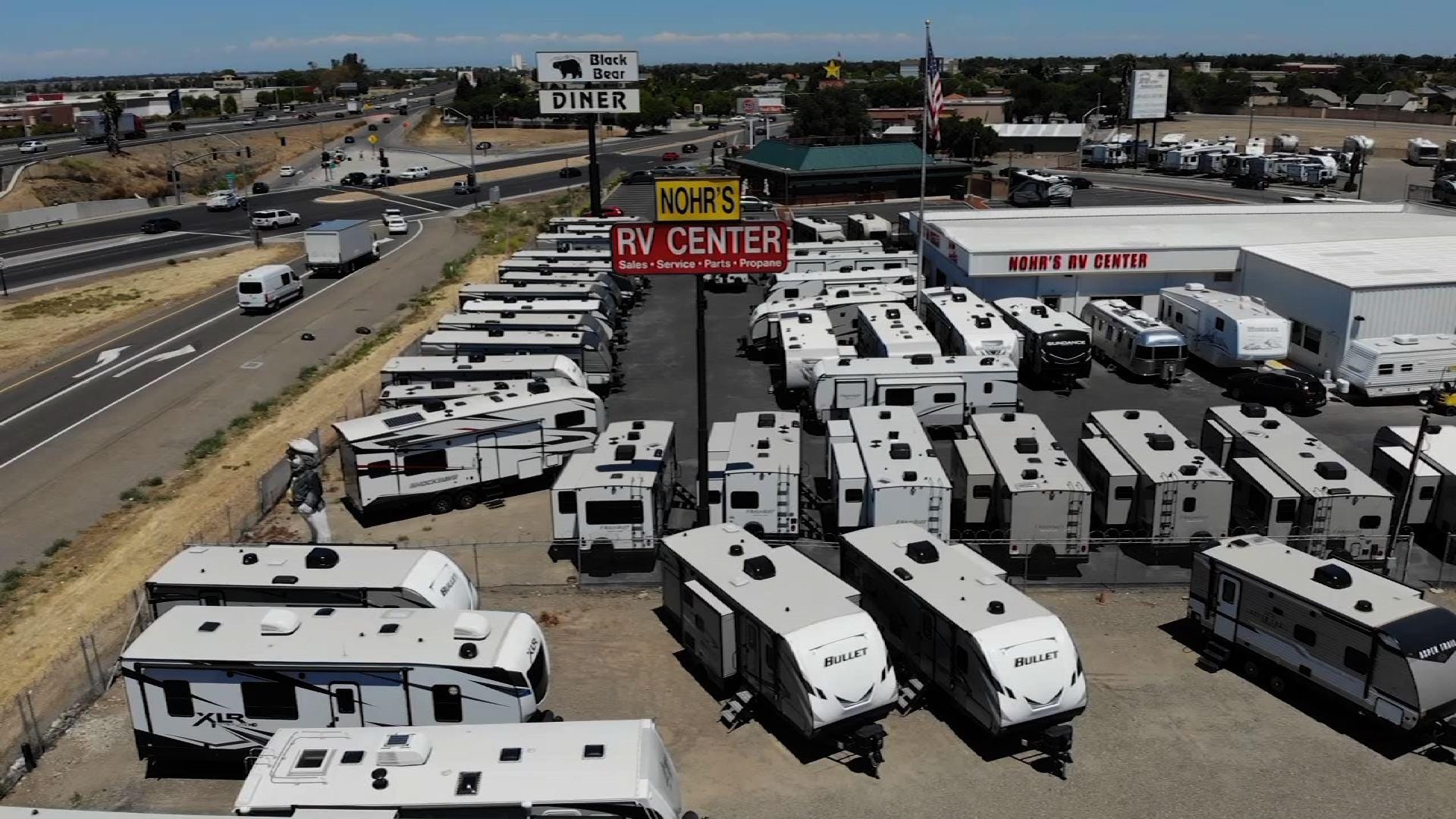
RV sales surge as travelers seek to avoid crowds
Americans eager to hit the road during the pandemic are fueling a boom in RV sales and travel. Sales of recreational vehicles are surging, along with bookings at RV campgrounds, as vacationers seek ways to travel safely and explore nature. (June 15)
AP
If you still have doubts about whether the U.S. will slip into a recession, perhaps this will dispel them: the RV industry is significantly weakening.
A slump in recreational vehicle sales has long been considered an early warning sign of a broader economic downturn because an RV is such a discretionary, big-ticket purchase. It thus reflects a shift in the mood of the American consumer before other types of spending, the theory goes. And consumption makes up about 70% of the U.S. economy.
The Elkhart, Indiana, metro area, where about 80% of RVs are produced, is similarly viewed as a leading gauge of where the U.S. is headed because the region is so dependent on the industry.
In November, RV shipments from manufacturers to dealers tumbled 50.4% from the same period a year earlier to 24,445, according to the RV Industry Association (RVIA). In 2022, wholesale RV shipments totaled 472,691, 15.6% below the year-ago figure, the trade group says.
“If production doesn’t rebound, it’s a very strong signal we will be moving into a recession next year,” says Michael Hicks, an economics professor at Ball State University who studies the industry.
Consumer target, Wall Street darling: Southwest may be hated by stranded consumers, but Wall Street till likes it
Arctic blast may aid shoppers: Post-Christmas bargain hunters may be thanking the bomb cyclone this week. Here’s why.
Is the RV craze over?
Keep in mind the industry notched record shipments of 600,240 in 2021 as people wary of traditional travel options during the pandemic or frustrated by COVID-19-related airline restrictions splurged on RVs and hit the open road. Shipments continued to break records through May 2022 before moderating in June and falling sharply the second half of the year.
RVIA says makers simply have been dialing back production to historic pre-pandemic levels as the health crisis has eased.
“What we are seeing now is the expected normalization off of that record production as the industry settles back to production levels more in line with our 10-year average,” RVIA said in a statement. “The desire for outdoor experiences and travel remains strong among the American public.”
This year marked the third-strongest ever for RV shipments, the group says. Monika Geraci, an RVIA spokeswoman, says “it is important to look at the full year to get the full picture.”
But Hicks said the slowdown in recent months represents more than a return to the pre-COVID trend, noting November was the second-weakest of any month since 2016.
What happens when the Fed raises interest rates?
The slide, he added, can be traced to the Federal Reserve’s aggressive interest rate hikes to bring down inflation, with the Fed’s key rate rising by more than 4 percentage points this year. That has sharply increased borrowing costs for RV buyers, who almost always finance their big purchases, Hicks says.
RV prices average $5,000 to $63,000 for a trailer and $80,000 to $140,000 for a motor home but can range up to $1 million, RVIA says. Interest rates to finance the purchases now average 4.89% to 11.89%, according to Bankrate.
With rates rising and recession fears growing, “you’ll be pretty careful” about financing an RV, Hicks says. “You’re still going to go out to a restaurant or take a trip.”
No Santa Claus on Wall Street? Santa Claus rally hasn’t come yet. There’s still time, but will it even matter for stocks?
Advice for lottery winners: What the Mega Millions $640M jackpot winner should do next: Stay quiet, hire financial team
But as rates rise and take a bigger toll on Americans’ pocketbooks, they’ll cut back even on those activities, leading to a recession, Hicks says. RVs, he adds, are a good warning signal because the impact on the industry is larger and happens sooner than in other sectors.
High gasoline prices also have helped dampen sales and shipments of fuel-chugging RVs (even if they’re towed), though that has been less of a factor recently as pump costs have fallen, Hicks says.
What is the current state of the economy?
Other economic indicators have been mixed recently. Housing and manufacturing have weakened substantially. Consumer spending has softened but is still solid, partly because household finances are in good shape. Job growth has slowed but remained sturdy. And business investment has held up surprisingly well.
Most economists are expecting a mild recession next year as the Fed rate hikes increasingly squeeze consumers and businesses, according to monthly surveys by Wolters Kluwer Blue Chip Economic Indicators. But some research firms, including Goldman Sachs and Moody’s Analytics, believe the U.S. will narrowly avoid a slump.
Hicks says he had predicted a “soft landing” for the economy that dodges recession but changed his forecast after studying the latest RV figures.
Although every downturn over the past four decades has been preceded by an RV slump several months earlier, most – but not all – declines in RV shipments have been followed by recessions, Hicks says. He says he’s more confident a recession is coming this time because the pullback in RV shipments has been dramatic.
“Falling RV sales are not always, in and of themselves, a recession indicator,” says Gus Faucher, chief economist of PNC Financial Servicers Group. But, he said, “I do think what’s going on with RVs in late 2022 is an indication that high interest rates are starting to drag on the economy. … The economy will feel the impact of those high interest rates more fully and broadly in 2023.”
The Elkhart area saw its unemployment rate rise to 2.8% in November, highest since June 2021, but that’s still well below the nation’s jobless rate. So far, most RV manufacturers are trimming hours and extending holiday production hiatuses rather than laying off workers because of longstanding worker shortages, Hicks says.
What does it mean when the yield curve is inverted?
RV sales aren’t the only economic bellwether flashing red.
Normally, interest rates are higher for longer-term bonds than shorter-term ones because investors need to be rewarded for risking their money for a longer period.
Yet the yield on the 2-year Treasury bond has hovered above the 10-year Treasury since July and remains about half a percentage point higher. Such an “inversion of the yield curve” has been a reliable signal of a coming recession because investors move money into safer longer-term assets – pushing their prices up and their yields down – when the economic outlook grows dimmer.
But the lag between a yield curve and inversion and recession has been imprecise in recent decades, ranging up to 22 months, according to research firm Statista.

